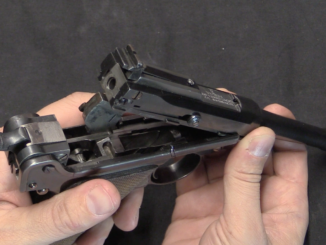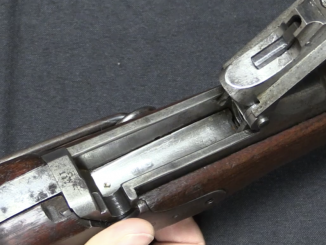So, this is a video I took over a year ago, and then lost track of – a prototype .25ACP Savage pistol. It is plain blowback, not using the rotating-barrel mechanism of the mainstream .32 Savage pistols. Savage made several different types of .25 prototypes, but never ended up putting any of the into production.
Related Articles

Conversion
Axel Peterson’s Complicated .22 Luger Conversion at James D Julia
Axel Peterson was a Swedish immigrant who became a very respected gunsmith in the Denver area in the late 1800s, and whose shop remained in business until World War 2. Peterson was best known for […]

Interview
Jim Sullivan on the M16 in Vietnam
When I have the chance to interview Jim Sullivan, one of the original designers of the AR15, one of the subjects that came up (not surprisingly) was the record of failures of the M16 early […]

Conversion
Prototype Tube-Magazine Trapdoor Springfield
Lot 1078 in the September 2020 RIA Premier auction. This experimental repeating conversion of a Trapdoor Springfield was most likely made by Augustine Sheridan Jones, of the Dakota Territory in the 1880s. We know he […]

I suspect the milled-out area on top of the slide was also to reduce slide mass. The cutout on the left side probably wasn’t quite enough to ensure sufficient slide velocity for reliable ejection, so the groove on top was just that “little bit more ‘less’*” that made things work.
(* Yes, this is a Monty Python reference- see “Whizzo Butter dead crab sketch”. 😉 )
A production version might have had such a “groove” on both sides of the slide top, and the slide’s side panels under the gripping ridges thinned just a bit to bring the mass down to the figure determined by experiments with this one. They might even have reduced the number of “ribs”, as even one or two off each side would have further reduced mass.
It’s a nice design. I’d have bought one.
Merry Christmas to you and all, Ian.
cheers
eon
I agree for a “public production” pistol, or even better make the slide of Titanium. I would have liked one with NO milled-out areas. The extra mass would make an interesting piece to “hot-rod” with reloads for more velocity/power, As for grip-ridges, I prefer knurling on the slide and grip areas instead; the enemy of efficiency in “a serious social misunderstanding” being the loss of “traction” due to sweat, mud or blood. Being a relic of the pre-Cambrian epoch as well as a charter member of the Old Curmudgeon Society I am still waiting for a .25 ACP Long that can be employed in dress-up social events.
On that account, I’ve often thought that a pocket pistol in 5.7 x 28 FN would be highly interesting. Ballistically, it would be in the .22 WMRF class, which wouldn’t be too bad in a “hideout gun”.
cheers
eon
““hot-rod” with reloads for more velocity/power”
Can be .25 Auto hot-loaded to any noticeable degree? I always think that small capacity prevent it.
“pocket pistol in 5.7 x 28 FN”
How to combine quite long cartridge (40mm of overall length – for example the 7.62 Tokarev has 34mm) with small size of pocket automatic pistol?
FN makes it work in a standard-sized service pistol with a double-column magazine, so I see no reason it couldn’t work in a pocket pistol with a single-column box.
40mm is a bit over 1.5 inches, which with a single-column magazine and allowing for a mainspring down the backstrap would yield a grip about 2 inches front to back (about 51mm). To be charitable, call it 2.25 inches (58mm).
That’s still not particularly outlandish, compared to the grips of typical 6.35mm/.25 ACP pistols, let alone those in .22 LR. For instance, the S&W Model 61 Escort.
One of the smallest .25 ACPs ever, the pre-WW2 Mauser WTP, had a grip measuring 1.34 inches (33.5mm) front to back at the base of the trigger guard. The difference between that micro-gun and this hypothetical pocket arm would be about 15mm, or 0.59 inch.
In an arm with a magazine housed in the grip, the diameter of the round at the case head is generally a more critical factor in “grip feel” than its OAL. In this respect, the 5.7 x 28mm, with a base diameter of 7.9 mm (0.311 in), isn’t that much bigger than the .25 ACP, with its semi-rim diameter of 7.7 mm (0.302 in).
And since the 5.7 is a true rimless round with a rim diameter of 7.8mm (0.307 in), you wouldn’t have to worry about getting a round in the magazine with its semi-rim “behind” the one below it, let alone the rim-
positioning issues with rimfire rounds. I suspect that a 5.7 pocket pistol could be made much more feed-reliable than most .25 or .22 pocket arms, both due to cartridge case configuration (rimless, bottlenecked) and due to having more than enough recoil force to operate the mechanism.
I doubt a 5.7 FN pocket auto would need to have the slide mass reduced to ensure enough slide retraction velocity for reliable ejection. OTOH, I suspect it would have a noticeable kick.
In exchange, it would “kick” the target substantially harder than a .25 ACP or .22 LR.
An acceptable tradeoff, IMHO. And it would finally provide a reasonable rationale’ for the 5.7 x 28mm cartridge, which it sorely lacks with the FN 90 and Five-Seven platforms.
.22 WMR ME has its place in the defensive arena. I don’t believe either a full-on PDW or service handgun is that place.
IMPO, either one makes a nice, handy “trail gun”- or would, if the ammunition wasn’t so darned expensive. (Average 39 cents/rd vs. av. 27 cents/rd for .22 WMR most place in the U.S.)
cheers
eon
Managing the opening speed of breechbolt with a bottlenecked case and very high inital velocity bullet in a service sized pistol should be hard enough since FN used a delay system with moving barrel running backwards at half speed of breech closing piece. In a west pocket pistol, it should be harder than greater sized big brother. But, using a magazine repeater like “Gallois” might be more convenient.
The Soviets came up with the 5.45×18 more than 40 years ago and I think it’s still the “ideal” true pocket pistol cartridge. Not as powerful as 5.7×28 of course, but a good deal more powerful than .25 ACP. There are anecdotal stories of low stopping power, but then again, such stories exist for most self defense pistol cartridges, especially if FMJ bullets were used. The 5.45×18 has enough muzzle velocity that an expanding bullet could probably be easily developed. Max. pressure is about 25,000 PSI, so probably supersonic loads are possible as well (the Soviet/Russian loads are high subsonic).
As for a hopped-up .25 ACP, American Derringer once advertised a .250 Magnum. I don’t think that I ever saw a review of it.
“How to combine quite long cartridge (40mm of overall length – for example the 7.62 Tokarev has 34mm) with small size of pocket automatic pistol? ”
blow forward mecanism is a solution.
The 5.45×18 is very cool. Te 5.7 not so much. I have been having fun with the .22 TCM and its 9R version. Compact high intensity cartridges are hugely interesting and under appreciated.